Abstract
PURPOSE: To encourage a balanced approach to blood glucose monitoring in diabetes by a critical review of the history, power and cost of glucose testing. DATA SOURCES: The Cambridge Data Base was searched and was supplemented by a random review of other relevant sources, including textbooks, company pamphlets, and laboratory manuals. STUDY SELECTION: Keywords used were "glucosuria diagnosis," "blood glucose self-monitoring," "glycosylated hemoglobin," and "fructosamine" for the 10-year period ending 1992, restricted to English language and human. DATA EXTRACTION: About 200 titles were retrieved and reviewed according to the author's judgment of relevance. FINDINGS: "Snapshot tests" (venous and capillary blood glucose) and "memory tests" (urine glucose, glycated hemoglobin fractions and fructosamine) must be employed according to individual patients treatment goals. Day-to-day metabolic guidance is facilitated by capillary blood glucose testing for patients receiving insulin and by urine glucose testing for others. Capillary blood glucose testing is mandatory in cases of hypoglycemia unawareness (inability to sense hypoglycemia because of neuropathy) but is not a substitute for a knowledge of clinical hypoglycemia self-care. Criteria by reason (clinical judgement and cost effectiveness) must be separated from criteria by emotion (preoccupation with technology and marketing). No randomized studies show that any of these tests consistently improve clinical outcome. Optimal metabolic control and cost savings can be expected from a rational selection of tests.
Full text
PDF
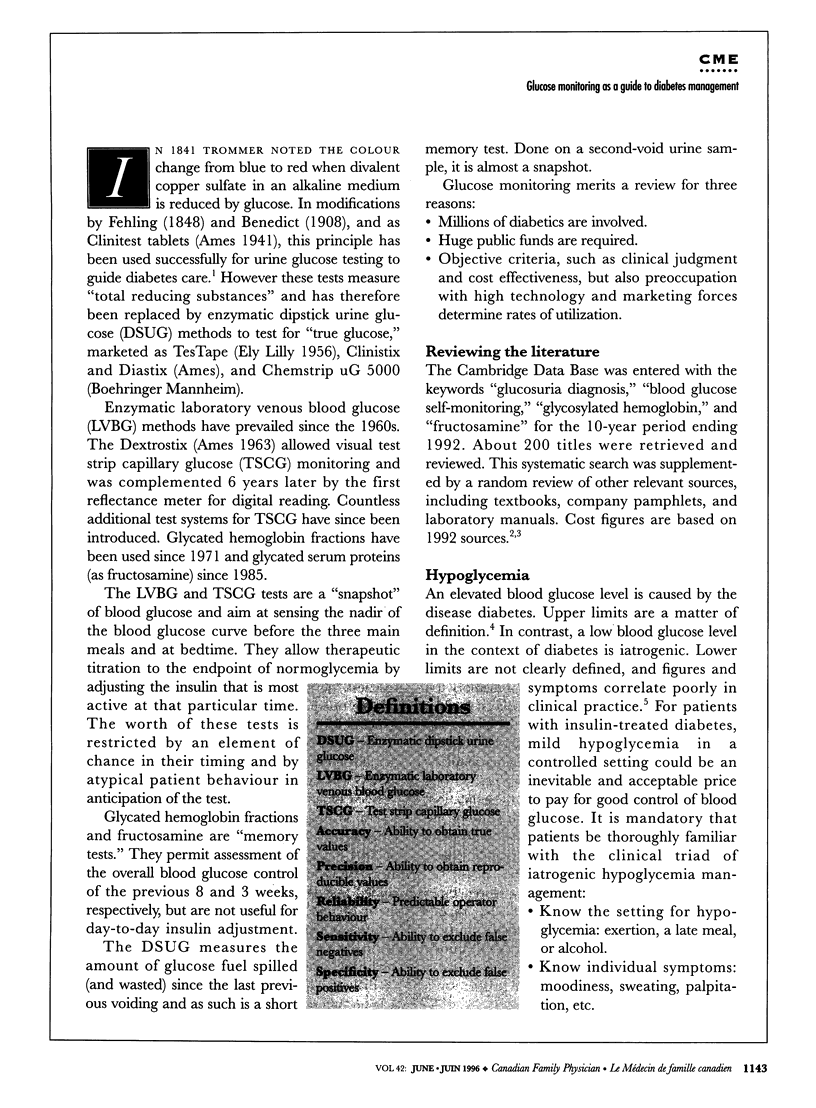
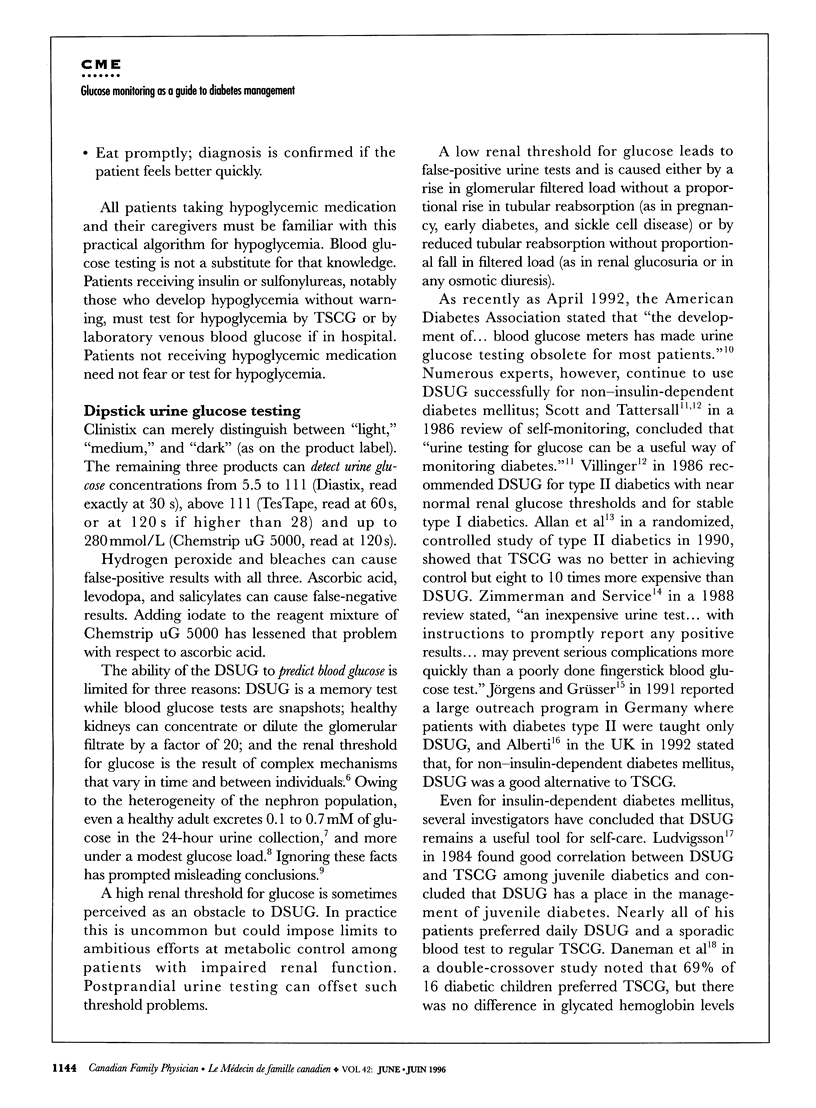
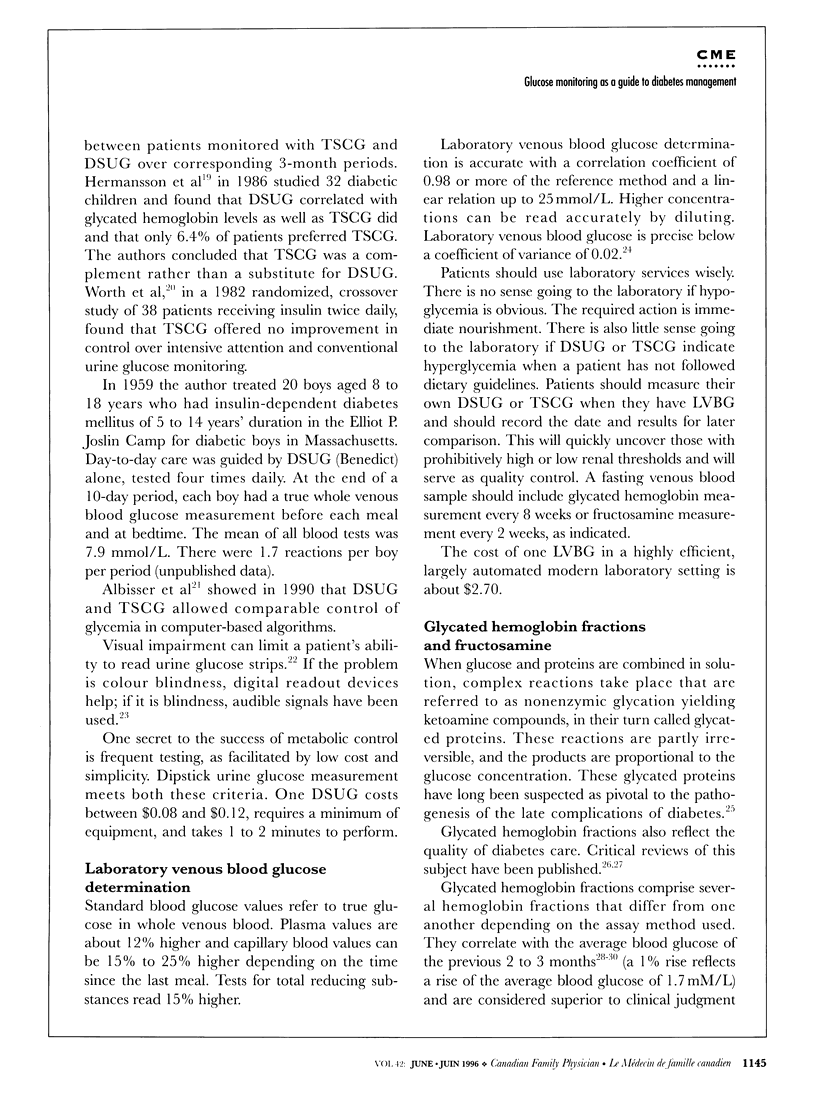
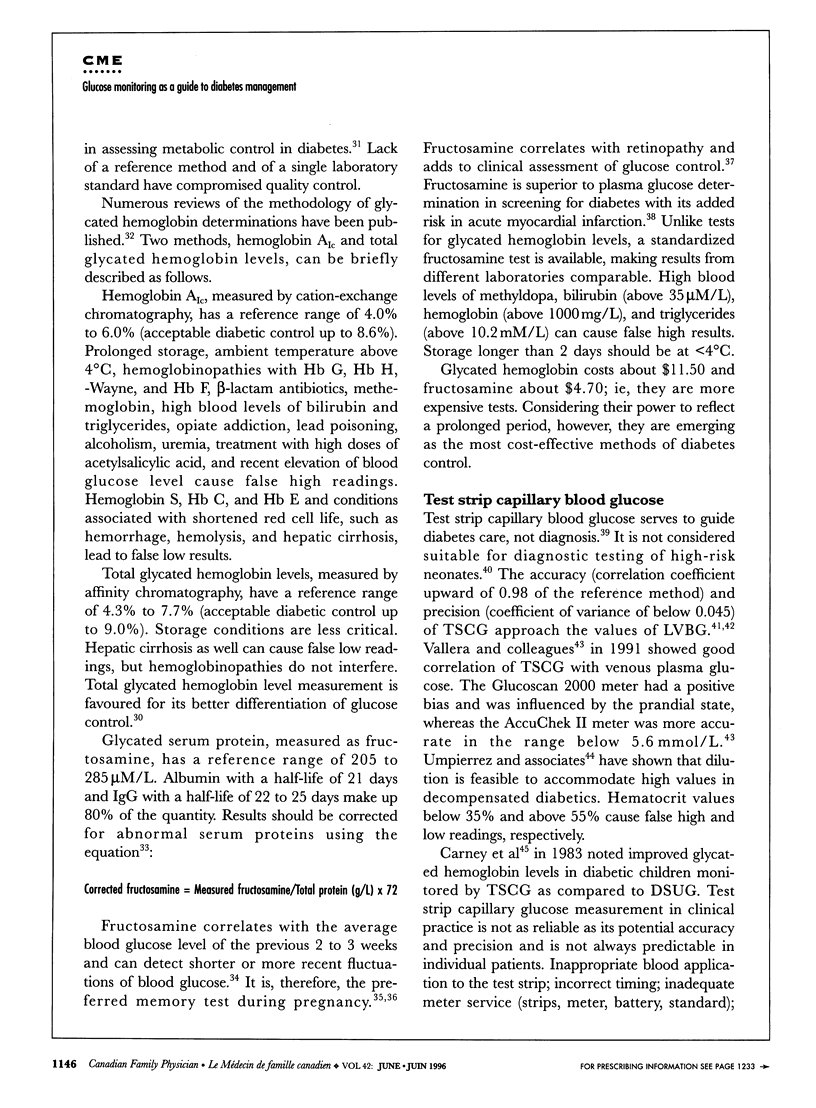

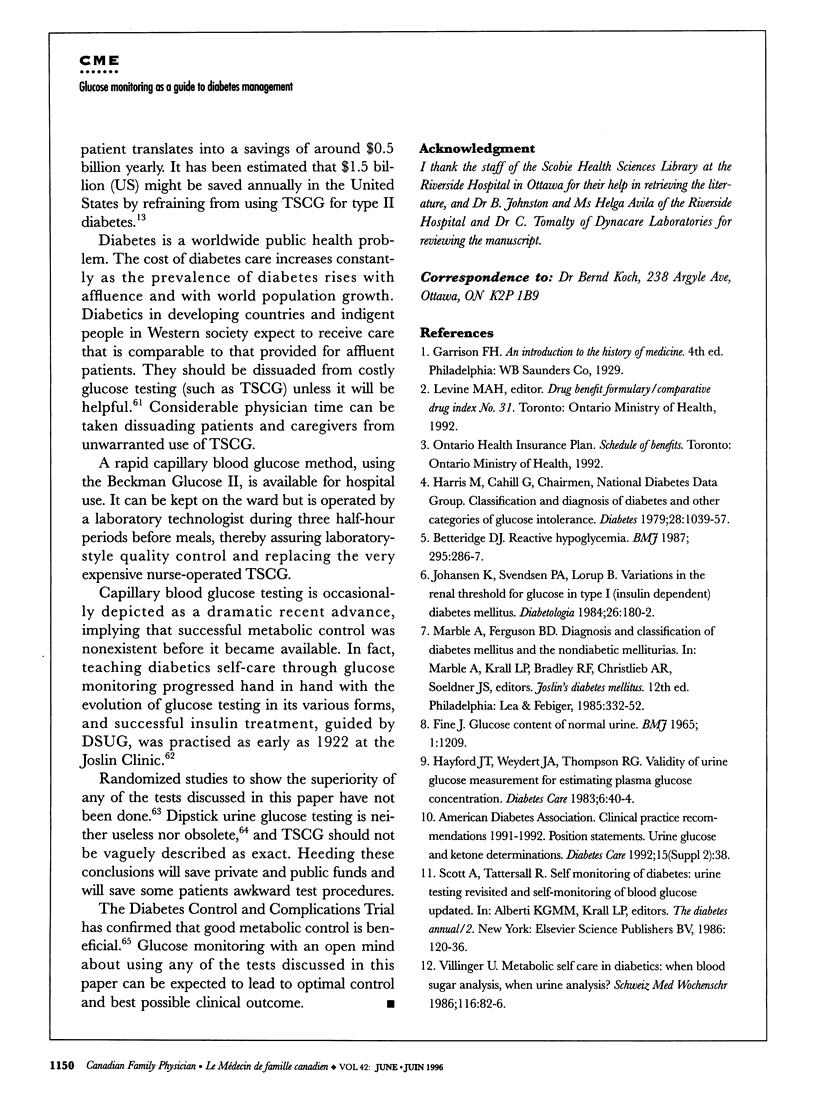
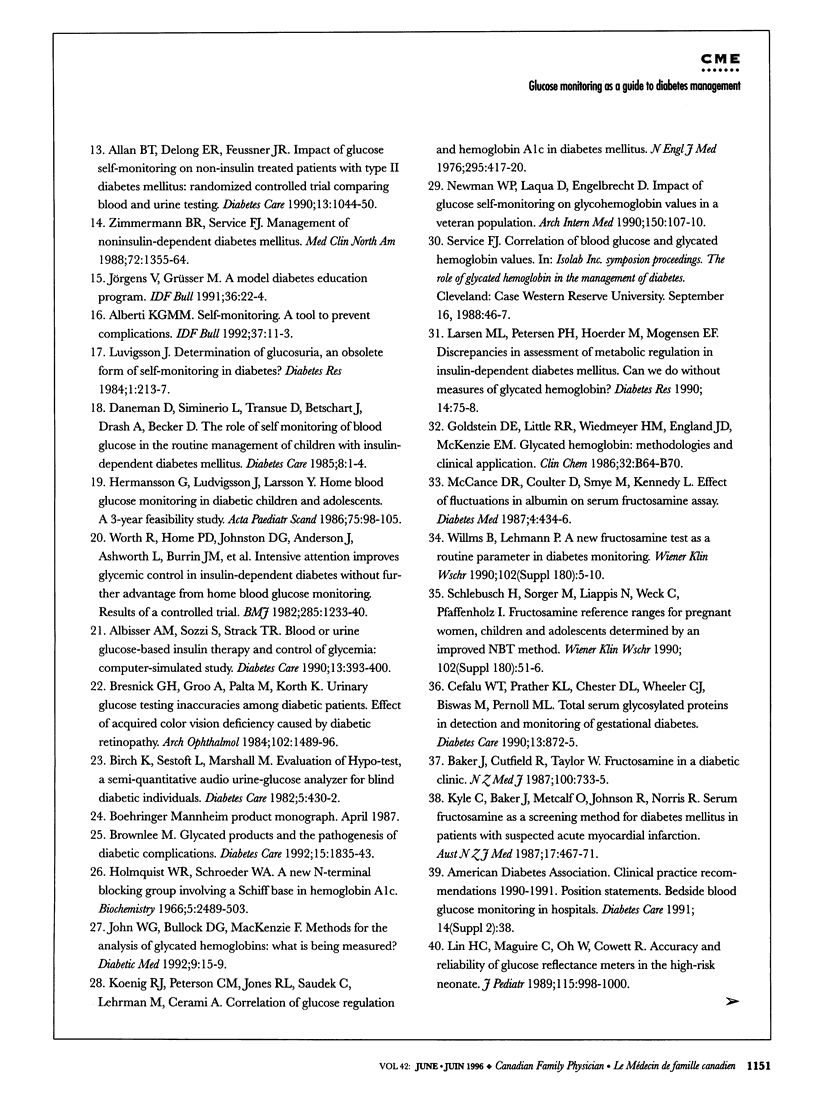
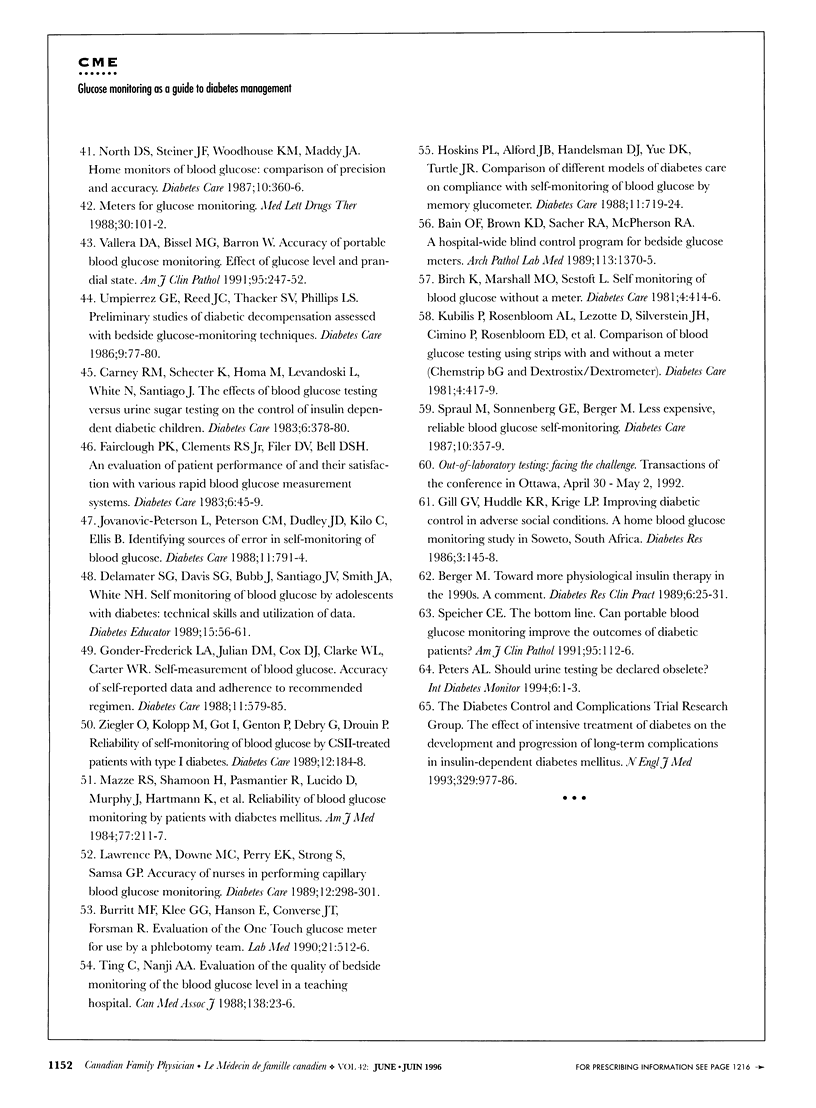
Selected References
These references are in PubMed. This may not be the complete list of references from this article.
- Albisser A. M., Sozzi S., Strack T. R. Blood or urine glucose-based insulin therapy and control of glycemia. Computer-simulation study. Diabetes Care. 1990 Apr;13(4):393–400. doi: 10.2337/diacare.13.4.393. [DOI] [PubMed] [Google Scholar]
- Allen B. T., DeLong E. R., Feussner J. R. Impact of glucose self-monitoring on non-insulin-treated patients with type II diabetes mellitus. Randomized controlled trial comparing blood and urine testing. Diabetes Care. 1990 Oct;13(10):1044–1050. doi: 10.2337/diacare.13.10.1044. [DOI] [PubMed] [Google Scholar]
- Bain O. F., Brown K. D., Sacher R. A., McPherson R. A. A hospital-wide blind control program for bedside glucose meters. Arch Pathol Lab Med. 1989 Dec;113(12):1370–1375. [PubMed] [Google Scholar]
- Baker J., Cutfield R., Taylor W. Fructosamine in a diabetic clinic. N Z Med J. 1987 Dec 9;100(837):733–735. [PubMed] [Google Scholar]
- Betteridge D. J. Reactive hypoglycaemia. Br Med J (Clin Res Ed) 1987 Aug 1;295(6593):286–287. doi: 10.1136/bmj.295.6593.286. [DOI] [PMC free article] [PubMed] [Google Scholar]
- Birch K., Hildebrandt P., Marshall M. O., Sestoft L. Self-monitoring of blood glucose without a meter. Diabetes Care. 1981 May-Jun;4(3):414–416. doi: 10.2337/diacare.4.3.414. [DOI] [PubMed] [Google Scholar]
- Birch K., Sestoft L., Marshall M. Evaluation of Hypo-test, a semiquantitative audio urine-glucose analyzer for blind diabetic individuals. Diabetes Care. 1982 Jul-Aug;5(4):430–432. doi: 10.2337/diacare.5.4.430. [DOI] [PubMed] [Google Scholar]
- Bresnick G. H., Groo A., Palta M., Korth K. Urinary glucose testing inaccuracies among diabetic patients. Effect of acquired color vision deficiency caused by diabetic retinopathy. Arch Ophthalmol. 1984 Oct;102(10):1489–1496. doi: 10.1001/archopht.1984.01040031209020. [DOI] [PubMed] [Google Scholar]
- Brownlee M. Glycation products and the pathogenesis of diabetic complications. Diabetes Care. 1992 Dec;15(12):1835–1843. doi: 10.2337/diacare.15.12.1835. [DOI] [PubMed] [Google Scholar]
- Carney R. M., Schechter K., Homa M., Levandoski L., White N., Santiago J. The effects of blood glucose testing versus urine sugar testing on the metabolic control of insulin-dependent diabetic children. Diabetes Care. 1983 Jul-Aug;6(4):378–380. doi: 10.2337/diacare.6.4.378. [DOI] [PubMed] [Google Scholar]
- Cefalu W. T., Prather K. L., Chester D. L., Wheeler C. J., Biswas M., Pernoll M. L. Total serum glycosylated proteins in detection and monitoring of gestational diabetes. Diabetes Care. 1990 Aug;13(8):872–875. doi: 10.2337/diacare.13.8.872. [DOI] [PubMed] [Google Scholar]
- Daneman D., Siminerio L., Transue D., Betschart J., Drash A., Becker D. The role of self-monitoring of blood glucose in the routine management of children with insulin-dependent diabetes mellitus. Diabetes Care. 1985 Jan-Feb;8(1):1–4. doi: 10.2337/diacare.8.1.1. [DOI] [PubMed] [Google Scholar]
- Delamater A. M., Davis S. G., Bubb J., Santiago J. V., Smith J. A., White N. H. Self-monitoring of blood glucose by adolescents with diabetes: technical skills and utilization of data. Diabetes Educ. 1989 Jan-Feb;15(1):56–61. doi: 10.1177/014572178901500115. [DOI] [PubMed] [Google Scholar]
- FINE J. GLUCOSE CONTENT OF NORMAL URINE. Br Med J. 1965 May 8;1(5444):1209–1214. doi: 10.1136/bmj.1.5444.1209. [DOI] [PMC free article] [PubMed] [Google Scholar]
- Gill G. V., Huddle K. R., Krige L. P. Improving diabetic control in adverse social conditions. A home blood glucose monitoring study in Soweto, South Africa. Diabetes Res. 1986 Mar;3(3):145–148. [PubMed] [Google Scholar]
- Goldstein D. E., Little R. R., Wiedmeyer H. M., England J. D., McKenzie E. M. Glycated hemoglobin: methodologies and clinical applications. Clin Chem. 1986 Oct;32(10 Suppl):B64–B70. [PubMed] [Google Scholar]
- Gonder-Frederick L. A., Julian D. M., Cox D. J., Clarke W. L., Carter W. R. Self-measurement of blood glucose. Accuracy of self-reported data and adherence to recommended regimen. Diabetes Care. 1988 Jul-Aug;11(7):579–585. doi: 10.2337/diacare.11.7.579. [DOI] [PubMed] [Google Scholar]
- Hayford J. T., Weydert J. A., Thompson R. G. Validity of urine glucose measurements for estimating plasma glucose concentration. Diabetes Care. 1983 Jan-Feb;6(1):40–44. doi: 10.2337/diacare.6.1.40. [DOI] [PubMed] [Google Scholar]
- Hermansson G., Ludvigsson J., Larsson Y. Home blood glucose monitoring in diabetic children and adolescents. A 3-year feasibility study. Acta Paediatr Scand. 1986 Jan;75(1):98–105. doi: 10.1111/j.1651-2227.1986.tb10164.x. [DOI] [PubMed] [Google Scholar]
- Holmquist W. R., Schroeder W. A. A new N-terminal blocking group involving a Schiff base in hemoglobin AIc. Biochemistry. 1966 Aug;5(8):2489–2503. doi: 10.1021/bi00872a002. [DOI] [PubMed] [Google Scholar]
- Hoskins P. L., Alford J. B., Handelsman D. J., Yue D. K., Turtle J. R. Comparison of different models of diabetes care on compliance with self-monitoring of blood glucose by memory glucometer. Diabetes Care. 1988 Oct;11(9):719–724. doi: 10.2337/diacare.11.9.719. [DOI] [PubMed] [Google Scholar]
- Johansen K., Svendsen P. A., Lørup B. Variations in renal threshold for glucose in Type 1 (insulin-dependent) diabetes mellitus. Diabetologia. 1984 Mar;26(3):180–182. doi: 10.1007/BF00252403. [DOI] [PubMed] [Google Scholar]
- John W. G., Bullock D. G., MacKenzie F. Methods for the analysis of glycated haemoglobins: what is being measured? Diabet Med. 1992 Jan-Feb;9(1):15–19. doi: 10.1111/j.1464-5491.1992.tb01708.x. [DOI] [PubMed] [Google Scholar]
- Jovanovic-Peterson L., Peterson C. M., Dudley J. D., Kilo C., Ellis B. Identifying sources of error in self-monitoring of blood glucose. Diabetes Care. 1988 Nov-Dec;11(10):791–794. doi: 10.2337/diacare.11.10.791. [DOI] [PubMed] [Google Scholar]
- Koenig R. J., Peterson C. M., Jones R. L., Saudek C., Lehrman M., Cerami A. Correlation of glucose regulation and hemoglobin AIc in diabetes mellitus. N Engl J Med. 1976 Aug 19;295(8):417–420. doi: 10.1056/NEJM197608192950804. [DOI] [PubMed] [Google Scholar]
- Kyle C., Baker J., Metcalf P., Johnson R., Norris R. Serum fructosamine as a screening method for diabetes mellitus in patients with suspected acute myocardial infarction. Aust N Z J Med. 1987 Oct;17(5):467–471. doi: 10.1111/j.1445-5994.1987.tb00098.x. [DOI] [PubMed] [Google Scholar]
- Larsen M. L., Petersen P. H., Hørder M., Mogensen E. F. Discrepancies in assessment of metabolic regulation in insulin-dependent diabetes mellitus--can we do without measurements of glycated haemoglobin? Diabetes Res. 1990 Jun;14(2):75–78. [PubMed] [Google Scholar]
- Lawrence P. A., Dowe M. C., Perry E. K., Strong S., Samsa G. P. Accuracy of nurses in performing capillary blood glucose monitoring. Diabetes Care. 1989 Apr;12(4):298–301. doi: 10.2337/diacare.12.4.298. [DOI] [PubMed] [Google Scholar]
- Lin H. C., Maguire C., Oh W., Cowett R. Accuracy and reliability of glucose reflectance meters in the high-risk neonate. J Pediatr. 1989 Dec;115(6):998–1000. doi: 10.1016/s0022-3476(89)80757-7. [DOI] [PubMed] [Google Scholar]
- Ludvigsson J. Determination of glucosuria, an obsolete form of self-monitoring in diabetes? Diabetes Res. 1984 Nov;1(4):213–217. [PubMed] [Google Scholar]
- Mazze R. S., Shamoon H., Pasmantier R., Lucido D., Murphy J., Hartmann K., Kuykendall V., Lopatin W. Reliability of blood glucose monitoring by patients with diabetes mellitus. Am J Med. 1984 Aug;77(2):211–217. doi: 10.1016/0002-9343(84)90693-4. [DOI] [PubMed] [Google Scholar]
- McCance D. R., Coulter D., Smye M., Kennedy L. Effect of fluctuations in albumin on serum fructosamine assay. Diabet Med. 1987 Sep-Oct;4(5):434–436. doi: 10.1111/j.1464-5491.1987.tb00904.x. [DOI] [PubMed] [Google Scholar]
- Newman W. P., Laqua D., Engelbrecht D. Impact of glucose self-monitoring on glycohemoglobin values in a veteran population. Arch Intern Med. 1990 Jan;150(1):107–110. [PubMed] [Google Scholar]
- North D. S., Steiner J. F., Woodhouse K. M., Maddy J. A. Home monitors of blood glucose: comparison of precision and accuracy. Diabetes Care. 1987 May-Jun;10(3):360–366. doi: 10.2337/diacare.10.3.360. [DOI] [PubMed] [Google Scholar]
- Spraul M., Sonnenberg G. E., Berger M. Less expensive, reliable blood glucose self-monitoring. Diabetes Care. 1987 May-Jun;10(3):357–359. doi: 10.2337/diacare.10.3.357. [DOI] [PubMed] [Google Scholar]
- Umpierrez G. E., Reed J. C., Thacker S. V., Phillips L. S. Preliminary studies of diabetic decompensation assessed with bedside glucose-monitoring techniques. Diabetes Care. 1986 Jan-Feb;9(1):77–80. doi: 10.2337/diacare.9.1.77. [DOI] [PubMed] [Google Scholar]
- Villiger U. Stoffwechsel-Selbstkontrolle bei Diabetikern: wann Blutzucker-, wann Urinkontrollen? Schweiz Med Wochenschr. 1986 Jan 18;116(3):82–86. [PubMed] [Google Scholar]
- Willms B., Lehmann P. Neuer Fructosamin-Test--als Routineparameter in der Diabeteskontrolle. Wien Klin Wochenschr Suppl. 1990;180:5–10. [PubMed] [Google Scholar]
- Worth R., Home P. D., Johnston D. G., Anderson J., Ashworth L., Burrin J. M., Appleton D., Binder C., Alberti K. G. Intensive attention improves glycaemic control in insulin-dependent diabetes without further advantage from home blood glucose monitoring: results of a controlled trial. Br Med J (Clin Res Ed) 1982 Oct 30;285(6350):1233–1240. doi: 10.1136/bmj.285.6350.1233. [DOI] [PMC free article] [PubMed] [Google Scholar]
- Ziegler O., Kolopp M., Got I., Genton P., Debry G., Drouin P. Reliability of self-monitoring of blood glucose by CSII-treated patients with type I diabetes. Diabetes Care. 1989 Mar;12(3):184–188. doi: 10.2337/diacare.12.3.184. [DOI] [PubMed] [Google Scholar]
- Zimmerman B. R., Service F. J. Management of noninsulin-dependent diabetes mellitus. Med Clin North Am. 1988 Nov;72(6):1355–1364. doi: 10.1016/s0025-7125(16)30711-8. [DOI] [PubMed] [Google Scholar]


